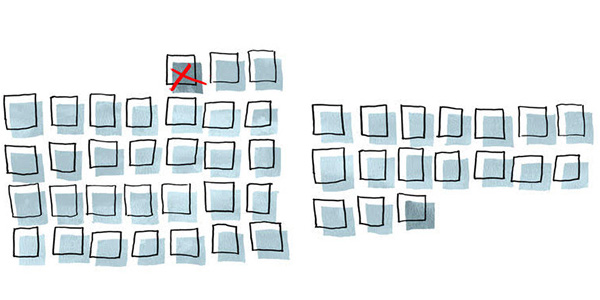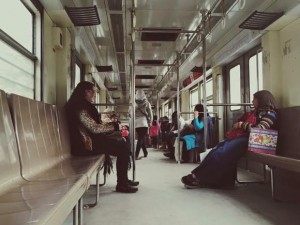Seven years after the introduction of Women-Only Metro carriages in Cairo, former resident Mae Wiskin explores what this intervention means for the city, public space and gender politics within Cairo and Egypt as a whole.
To many, Egypt’s capital city of Cairo is a maddening metropolis marked by its traffic gridlock, complex religious discourse, and contested gender politics. The metro system is frequently referred to as the only functional and dependable system in the city. It is available for only a single Egyptian pound, and runs fairly frequently. In its current configuration there are two women-only carriages attached to the middle of each train. The cars, which were formally introduced in 2007, enable women to travel more or less unmolested and fluidly around the sprawling metropolis. This makes Cairo one of several cities throughout the world, from Tokyo to Tehran to Mexico City, which have recently implemented similar women-only carriage policies for the purposes of public transit.
What has been the effect of such policies? As a Jewish-American woman of colour and a former resident of Cairo, I became interested in analysing whether gender segregation in the Cairo Metro is simply a matter of protecting women from sexual harassment, or whether it has come to play a role in the larger religious and cultural debate about the role of women in Egyptian society. While I was living in Cairo, I often engaged in lively conversations with Egyptians about these ideas. Later during graduate school, I conducted interviews with Cariene women to give a real voice to this often overlooked quotidian aspect of Egyptian life. Women-only carriages were never going to enter Egyptian society unnoticed and without criticism. Through these conversations and interviews, I realised that the consequences of urbanism (of which the metro is one example) on women’s rights in Cairo extend far beyond its transportation system. The existence of women-only carriages is just one feature of the national conversation about women and their place in public spaces — a paradigm that is still evolving.
The metro was built out of a powerful drive to create a globally-inviting Cairo. Its intentions were to lessen traffic congestion, increase more fluid public access through the city, and facilitate women’s safe passage. The metro is the circuit board of Cairo. It carries around three million people per day and is unarguably the fastest, cheapest and safest means of public transportation in the entire country. It is also one of few metro systems in Africa. Three lines and sixty-one stations connect over forty-eight miles of Cairo. It is a vibrant and veritable system.

View of downtown Cairo. Photo: Simon Mulvey
Until the women’s-only passenger cars were introduced, however, Cairene women were regularly subjected to gender-based violence, harassment, and unwanted touching on the mixed-gender trains. It is well documented that sexual harassment is a profound problem in Cairo. According to a 2013 UN report, a staggering 99% of women and girls reported having had experienced some form of sexual harassment. Still, Cairo is certainly not unique in its harassment issues. In Japan, for example, it has been reported that over 64% of women in their 20’s and 30’s reported being groped on the train or in transit stations. Indeed, the problem is so well recognised in Japan that there’s even a special name for subway sexual harassment: chikan.
Due to this, in 2000, women-only train carriages first appeared, aimed at protecting women from assault. In Egypt, women-only train carriages were only introduced when the government finally acknowledged its “epidemic” of sexual harassment. The role and make-up of government is a critical sticking point; according to the Global Report of the International Women’s Media Foundation, Egypt has a very low global ranking: 128th in terms of women’s representation in national office. This may in part explain some of the reasons why change in both the transit system and within the country as a whole has been so incremental. After the economic summit in Egypt on March 5th, 2015, the Egyptian Ambassador to the UN, Mervat Tallawy announced a national strategy to combat violence and harassment against women. The government purports that it is also drafting constitutional legislation that will specifically address violence against women in all its forms in the public sphere; the most common of which occurs on public transit. This is a revolutionary step towards helping to address gender-based violence against women in Egyptian society.
The debate over the role of women in Egypt is complex. According to Mona Makram-Ebeid, a former senior member of the Wafd party, “the islamic movement makes the accusation that women are invading public space and should be at home with their children”. She ultimately argues the conservative perspective that the women’s place is not in public life. Women are not to be seen, but should simply exist as quiet spectators. Moreover, many Egyptian males claim that women in the workplace is a primary source of congestion on the public transportation system, while also exacerbating the problem of male unemployment. This is simply one perspective and there are myriad arguments, which counter these assertions.
The Egyptian Gazette, presents both sides of the debate by stating the following: “since women have called for equality with men in all spheres of life, it is natural that she should fight like him for an empty seat”. In theory this proposition is fair; however, in reality, the picture of gender equality is far more complicated than the “fight” over a metro seat. One interviewee, Laila Abdel Hamid, poignantly and frankly frames the debate in this way:
“The presence of women-only carriages opens up an interesting platform for urban discourse about equality in ownership of public space. It’s a double-edged sword in my opinion. On the one hand, it offers women a space to feel comfortable and possibly safer from harassment, but on the other hand, it contributes to the ongoing gender segregation process and acts as a constant reminder that women are different from men.”
These interviews demonstrated how gender segregated public transportation has become a proxy that highlights contested gender dynamics in cosmopolitan Cairo.
There are yet other voices that argue against the women-only carriage policy. The Egyptian Gazette, in speaking about segregation in subway cars wrote, “it pulls us back to the dark ages of segregation and even humiliates our women, treating them as weak and subordinate”. Adding yet another dimension to the debate, journalist Jessica Valenti of The Guardian brings up the critical point of calling on men to take responsibility:
“There’s no doubt the harassment women face in public spaces needs to be addressed…. We’ve been subjected to regular catcalls and groping for far too long. But while the idea of a safe space is compelling, this international trend – which often comes couched in paternalistic rhetoric about “protecting”women – raises questions of just how equal the sexes are if women’s safety relies on us being separated. After all, shouldn’t we be targeting the gropers and harassers? The onus should be on the men to stop harassing women, not on women to escape them.”
These conflicting assertions illustrate the complexity behind the ongoing debate surrounding women-only carriages. Beyond the contentious discourse, the question of who has an actual right to public spaces in Cairo is fundamental to understanding how women-only carriages might serve as a site for transformative urbanism. It is important to note that all public spaces in Cairo are highly gendered. Men maintain a sense of entitlement over the public sphere, which makes it difficult for women to meaningfully break through those barriers in order to access those spaces freely. Given that Egypt is a male-dominated society, women are forced to constantly negotiate with patriarchal systems. In the public realm, women establish respectability and a sense of personal safety via their conservative dress and physical separation from men. Egyptian women are now actively trying to renegotiate the landscape of public space.
Separate from the ongoing discourse, the quotes below from two Egyptian women help illustrate how women actually experience the public sphere, highlighting the significance of the women-only carriages. In the words of resident Laila Abdel Hamid:
“Women in Cairo are exposed to different types of sexual harassment on a daily basis, especially while taking public transportation but also by simply walking around the city. While you’re walking in or out of the metro station, harassment happens too. But if you make it to the women only carriages, you’re relatively ok, because women surround you and if a male intruder is spotted, women riders will group together to expel him.”
When asked about women-only carriages by a BBC correspondent, one middle-class Cairene woman answered by saying, “we should have one or two more carriages. It is not asking too much to breathe, is it?”
There is a growing worldwide trend towards gender segregated public transportation, but it is interesting to note that while women do not have to use women-only carriages, in transit systems such as Cairo’s and Osaka’s in Japan, no legal sanction can be taken against men who enter women-only carriages. In addition, it is important to mention that women-only train carriages are usually located at the very end of the train. This forces women to walk the length of the train in order to access them. What’s even more problematic is that women-only train carriages are not available on all trains and/or at all times of the day. They are usually only provided during rush hours. This raises questions about the efficacy behind integrating such design features if they are not backed with legal force or with an adequate semblance of consistency.
I contend that the design of the Cairo metro not only transfigured the city, but also significantly transformed gender politics within the country. From the interviews I conducted, I got the sense that though women-only trains are appreciated, women still worry that they may only enhance divisions between the sexes and even worse, prevent necessary action to government policies aimed at designing more welcoming, safer and more inclusive public spaces. I would argue that Egyptians are only just beginning to acknowledge their city’s positive transformative urbanism and as such, are still contending and grappling with what its consequences may mean for their society. Debates over gender discrimination and sexual assault are no longer taboo issues in the country. This, in and of itself, illustrates the transformative power of the women-only carriages and how this design feature can be perceived as both a measure of moral progress and a move towards more inclusive urban development in Cairo. Now that women-only carriages have been used to encourage public engagement, other aspects of the city can be analysed in order to continue redesigning and positively transforming both societal and institutional relationships within Cairo.
Mae Wiskin is a writer and design researcher in New York City. She currently lives in Brooklyn and is a graduate student and teaching fellow at Parsons The New School for Design in Manhattan. Mae is obtaining a Masters Degree in Design Studies and her thesis examines the intersection between smart technologies and adult psychopathology.






What Does That Even Mean? Ten Things About “Service Design.”
By Mae Wiskin
Admittedly, I didn’t know what “service design” was a couple months ago (although arguably it has been around my entire life). Until recently service design lacked an agreed upon name or consensus. Service design, most simply, is a hybrid human activity composed of a blending of diverse industries and fields. Given this, there is no simple and clean definition of the term. If you were to ask forty different people what they think service design is and what the future of it might be, you will get forty different responses, albeit with some degree of overlap. As you can probably guess, the main place of overlap is the belief that design ought to be “human-centric.” I would argue, however, that design (in all its forms) has the capacity to be profoundly harmful unless its definition also always incorporates a sense of criticality.
At the recent Global Service Design Conference, held at Parsons The New School for Design, my team and I asked numerous participants what they believed was the future of service design. At the end, we compiled these insightful and often playful perspectives into a simple 6-minute podcast.
What follows is a short list of ten things I learned during the conference.
Posted in Issues/Commentary